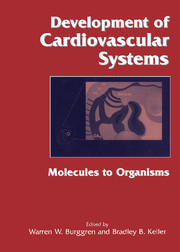Book contents
- Frontmatter
- Contents
- List of contributors
- Foreword by Constance Weinstein
- Introduction: Why study cardiovascular development?
- Part I Molecular, cellular, and integrative mechanisms determining cardiovascular development
- Part II Species diversity in cardiovascular development
- Part III Environment and disease in cardiovascular development
- 17 Oxygen, temperature, and pH influences on the development of nonmammalian embryos and larvae
- 18 Modeling gas exchange in embryos, larvae, and fetuses
- 19 Principles of abnormal cardiac development
- 20 In utero and postnatal interventions for congenital cardiovascular malformations
- 21 Applying the science of cardiovascular development to congenital cardiovascular malformations
- Epilogue: Future directions in developmental cardiovascular sciences
- References
- Systematic index
- Subject index
18 - Modeling gas exchange in embryos, larvae, and fetuses
from Part III - Environment and disease in cardiovascular development
Published online by Cambridge University Press: 10 May 2010
- Frontmatter
- Contents
- List of contributors
- Foreword by Constance Weinstein
- Introduction: Why study cardiovascular development?
- Part I Molecular, cellular, and integrative mechanisms determining cardiovascular development
- Part II Species diversity in cardiovascular development
- Part III Environment and disease in cardiovascular development
- 17 Oxygen, temperature, and pH influences on the development of nonmammalian embryos and larvae
- 18 Modeling gas exchange in embryos, larvae, and fetuses
- 19 Principles of abnormal cardiac development
- 20 In utero and postnatal interventions for congenital cardiovascular malformations
- 21 Applying the science of cardiovascular development to congenital cardiovascular malformations
- Epilogue: Future directions in developmental cardiovascular sciences
- References
- Systematic index
- Subject index
Summary
Introduction
This chapter introduces the “ideal” models used to study respiratory gas exchange in vertebrate embryos, fetuses, and larvae. The assumptions, simplifications, and limitations of each model are discussed, along with experimental tests. In some cases, departures from ideal behavior have themselves been modeled, including such phenomena as shunts, heterogeneous perfusion, and diffusion/perfusion inequality.
What is different about early life stages?
Gas exchange in early developmental stages has several unique characteristics and is always very different from that in adults of the same species. There may be no specialized gas exchange organ at all, as in most fish and amphibians, or there may be specialized gas exchange organs that are unique to embryonic or fetal life, as in amniote eggs or placental mammals. Gas exchange requirements increase exponentially during development as the embryo grows or converts yolk into metabolizing tissue; thus, there is never a true “steadystate” gas exchange, and conditions for gas exchange continuously change. Embryos always start development with a small enough body mass, and with a low enough oxygen consumption, to satisfy all gas exchange requirements by simple diffusion. “Simple” diffusion is complicated by a number of extraembryonic structures, however. The egg capsule of fish and amphibian eggs, composed of both fibrous and thick gelatinous layers, may impose a significant resistance to gas exchange because of its thickness. The shells of bird and reptile eggs similarly impose a resistance to diffusion external to the embryo. Eggs are sometimes laid in gelatinous masses (amphibians) or large clutches (reptiles), so that neighboring eggs may impose additional diffusion barriers and also decrease local oxygen concentrations.
- Type
- Chapter
- Information
- Development of Cardiovascular SystemsMolecules to Organisms, pp. 240 - 258Publisher: Cambridge University PressPrint publication year: 1998



